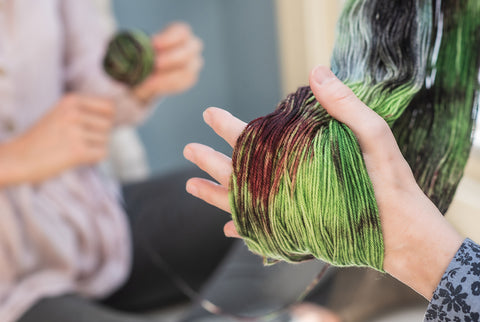Your Cart is Empty
Can you think of anything more magical than transforming a plain white skein of yarn into a kaleidoscope of deep, rich colour? This is the exquisite beauty of hand dyed yarn.
When deciding which hand dyed yarn to purchase, it is important to start with a high quality yarn. Our personal favorite is a merino/cashmere mix. Merino is softer than regular wool, making it perfect to wear next to your skin. It is also naturally creamy white, which is a perfect base for hand dying vibrant colours.
Cashmere is considered to be a luxury yarn that gets softer and softer with each wear. Merino and cashmere make for the perfect hand dyed yarn blend.

With so many methods of hand dying available, it can be difficult to choose. Here are a few of our favorite hand dying methods with pros and cons:
Yarn that is hand dyed in the speckled or splattered method has random splashes of colour. This method involves flinging or splattering dye directly onto the yarn.
What We Love: The one of a kind (OOAK) splattered effect is fun and playful, perfect for scarves, beanies, and blankets.
Challenges: Skeins vary greatly since the effect is entirely random.
Beautifully blended, tonal hand dyed yarn features multiple shades of the same or similar colours meshed together.
What We Love: Reminiscent of a Yuri Petranko watercolour, tonal hand dyed yarn is beautifully balanced and soft.
Challenges: Variations can be rather noticeable between skeins.
Making use of contrasting colours, the variegated hand dye method is a more patterned yarn. It typically consists of three or more colours in sequence.
What We Love: Colours are highly saturated and vibrant.
Challenges: Since variegated yarn has colours in a sequence, rows may begin to line up to form large blocks of colour, depending on your pattern.
If you are trying to achieve a gradual change in colour in your project, ombre hand dyed yarn is a great option. This type of hand dying involves long colour runs that seamlessly blend into one another.
What We Love: Before ombre, you would have to change skeins to achieve the colour blending that is afforded with ombre yarn.
Challenges: Ombre hand dyed yarn doesn't work for every project, so only use it for longer, more flowy pieces.
When you want to use multiple colours, but aren't going for a bold, dramatic effect, kettle-dyed yarn is the key. Kettle-dyed achieves a soft blend that still makes use of a few different colours.
What We Love: Multiple colours can blend together for a unified look with kettle-dyed.
Challenges: Because colours are irregularly placed, it is tough to know what the end result will be until it is knitted up.
Now that you understand the different methods of hand dying, is it possible to understand how it will behave?
The best way to get an idea of how a colourway will behave is to untwist it and inspect it closely. Unlike yarn dyed in yarn mills, hand dyed yarn is coloured after the skein is spun, so colour is especially irregular. The colour you see on the outside may be considerably different from the inside. It is important to understand exactly what you are working with before you get started and discover a surprise later.
The genuine beauty and craftsmanship of one of a kind hand dyed yarn far outweigh the challenges. Now that you have had a crash course on hand dyed yarn, it is time to get knitting!



